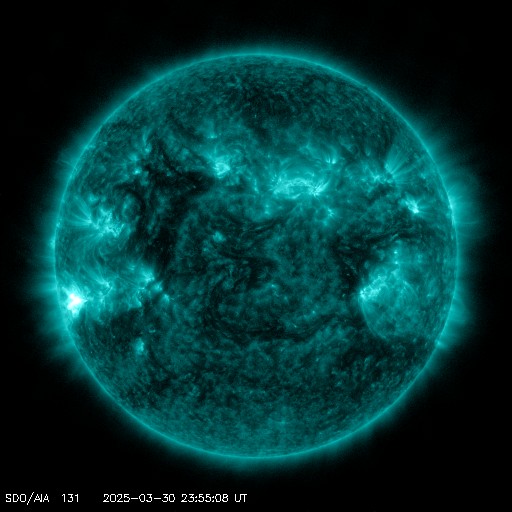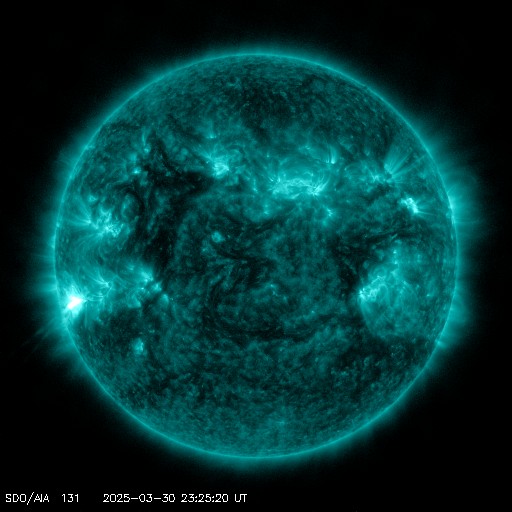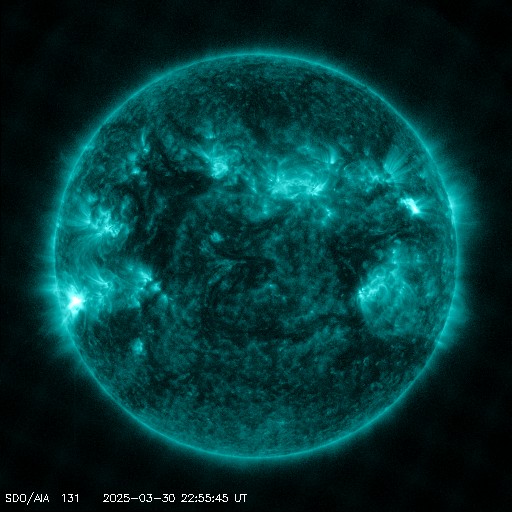Viewing archive of Wednesday, 2 March 2011
Solar activity report
Any mentioned solar flare in this report has a scaling factor applied by the Space Weather Prediction Center (SWPC). Because of the SWPC scaling factor, solar flares are reported as 42% smaller than for the science quality data. The scaling factor has been removed from our archived solar flare data to reflect the true physical units.
Report of Solar-Geophysical Activity 2011 Mar 02 2200 UTCPrepared by the NOAA © SWPC and processed by SpaceWeatherLive.com
Joint USAF/NOAA Report of Solar and Geophysical Activity
SDF Number 061 Issued at 2200Z on 02 Mar 2011IA. Analysis of Solar Active Regions and Activity from 01-2100Z to 02-2100Z
Solar activity was low. Region 1164 (N25E08) produced
a C1/Sf x-ray flare at 02/1318Z, the only flare of significance
during the period. Region 1164 decreased in area, but remained an
Ekc type spot group with Beta-Gamma-Delta magnetic characteristics.
New Region 1166 (N10E77) rotated onto the disk as an Hsx type spot
group with Alpha magnetic characteristics. A flux region emerged in
the northeast quadrant near N20E40.
IB. Solar Activity Forecast
Solar activity is expected to be low
for the next three days (03-05 March), however a chance exists for
an M-class event from Region 1164.
IIA. Geophysical Activity Summary 01-2100Z to 02-2100Z
The geomagnetic field was at active to minor storm levels for the
first 12 hours of the period and at quiet to unsettled levels for
the remainder. A recurrent coronal hole high speed stream remains
geoeffective. Solar wind speed at the ACE spacecraft remained
elevated at 640 km/s. The Bz component of the interplanetary
magnetic field began the period near -10 nT but slowly returned to
near neutral values by the end of the period. The greater than 2 MeV
electron flux at geosynchronous orbit reached high levels during the
period.
IIB. Geophysical Activity Forecast
The geomagnetic field is
expected to be unsettled to occasionally active for the next three
days (03-05 March) due to the continued influence of the coronal
hole high speed stream.
III. Event Probabilities 03 Mar to 05 Mar
| Class M | 35% | 35% | 35% |
| Class X | 05% | 05% | 05% |
| Proton | 05% | 05% | 05% |
| PCAF | Green | ||
IV. Penticton 10.7 cm Flux
Observed 02 Mar 113 Predicted 03 Mar-05 Mar 115/120/120 90 Day Mean 02 Mar 088
V. Geomagnetic A Indices
Observed Afr/Ap 01 Mar 018/031 Estimated Afr/Ap 02 Mar 015/017 Predicted Afr/Ap 03 Mar-05 Mar 015/015-012/012-010/010
VI. Geomagnetic Activity Probabilities 03 Mar to 05 Mar
| A. Middle Latitudes | |||
|---|---|---|---|
| Active | 30% | 25% | 20% |
| Minor storm | 15% | 10% | 05% |
| Major-severe storm | 01% | 01% | 01% |
| B. High Latitudes | |||
|---|---|---|---|
| Active | 40% | 25% | 25% |
| Minor storm | 15% | 15% | 15% |
| Major-severe storm | 10% | 05% | 05% |
All times in UTC
Current data suggests there is a slight possibility for aurora to appear at the following high latitude regions in the near future
Gillam, MB, Yellowknife, NTLatest news
Latest forum messages
Solar Demon 3Unspecified geomagnetic activity 2146AR4046 134Aurora photography hints for those of us with smartphones 54AR4048 34
More topicsSupport SpaceWeatherLive.com!
A lot of people come to SpaceWeatherLive to follow the Sun's activity or if there is aurora to be seen, but with more traffic comes higher server costs. Consider a donation if you enjoy SpaceWeatherLive so we can keep the website online!

Latest alerts
00:09 UTC - Solar flare
Moderate M1.03 flare
Sunday, 30 March 2025
23:51 UTC - Radio Blackout
Minor R1 radio blackout in progress (≥M1 - current: M1.03)
23:39 UTC - Solar flare
Moderate M1.52 flare
23:21 UTC - Radio Blackout
Minor R1 radio blackout in progress (≥M1 - current: M1.49)
23:09 UTC - Solar flare
Moderate M1.48 flare
Space weather facts
| Last X-flare | 2025/03/28 | X1.1 |
| Last M-flare | 2025/03/30 | M1.0 |
| Last geomagnetic storm | 2025/03/27 | Kp5 (G1) |
| Spotless days | |
|---|---|
| Last spotless day | 2022/06/08 |
| Monthly mean Sunspot Number | |
|---|---|
| February 2025 | 154.6 +17.6 |
| March 2025 | 127 -27.6 |
| Last 30 days | 127 -25.7 |





